Quick: What produce item do you most closely associate with Italy? If you said Italian tomatoes, we definitely think alike.
Italian tomatoes are more than just a cuisine staple. They’re practically the heart of Italian culture. (And they’re often heart-shaped too.)
Thanks to the Greatest Tomatoes from Europe and ANICAV, the Italian association of canned tomato producers, we now know – and appreciate – a lot more about Italian tomatoes. A fascinating trip to Italy earlier this month gave us a whole new perspective on tomatoes. We now have a clear insight into how Italian farmers and producers prepare these prized tomatoes for the rest of the world to enjoy.
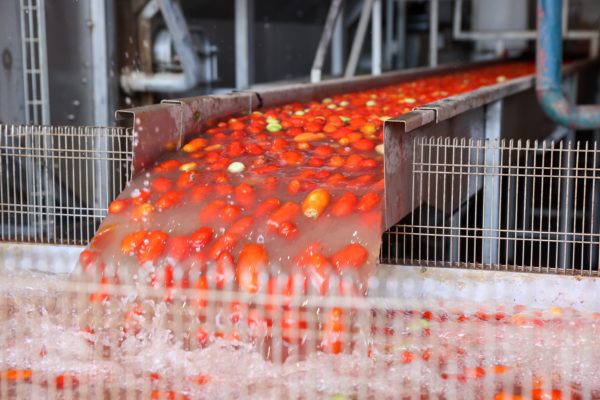
Here, we want to share with you a little bit about an Italian tomato’s journey from vine to can. To learn about this process, we got a behind-the-scenes look at the Calispa tomato production factory in Castel San Giorgio outside of Naples. This facility is located in the San Marzano region, Italy’s most famous tomato growing area.
San Marzano Italian Tomatoes
First, a little background: Why do people make such a big deal about San Marzano? Many people believe that San Marzano tomatoes are superior to all others in the world. For one thing, the region’s fertile volcanic soil is particularly rich in potassium carbonate, which boosts fruit ripening and sugar levels. The local farms also benefit from plentiful supplies of ground water, an efficient system of irrigation channels, and close proximity to the sea. Oh – and don’t forget about that perfect Mediterranean weather.
Altogether, these factors add up to the ideal conditions for growing tomatoes, especially the elongated cylindrical variety used in canned whole peeled tomatoes. These tomatoes are so flavorful that they don’t require the additives or flavoring ingredients that other canned tomatoes might need.
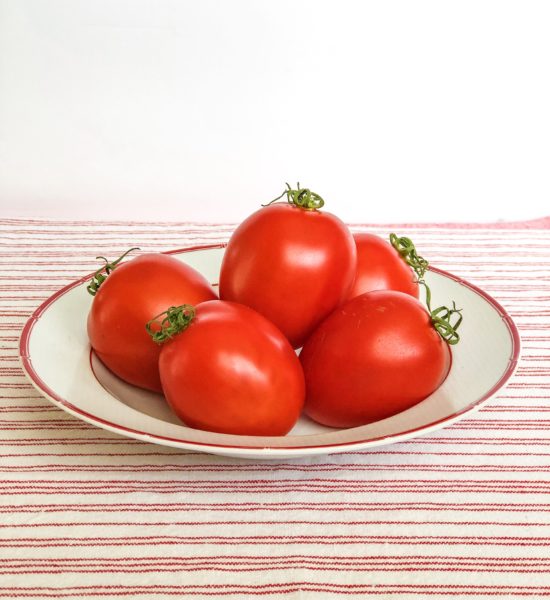
True, there are other places in the world that claim to produce “San Marzano style” tomatoes. But these tomatoes are the real deal (and many people say they can instantly tell the difference.)

In fact, there’s a Protected Denomination of Origin (PDO, or DOP using the Italian nomenclature) label for the San Marzano tomato. It’s called the San Marzano DOP dell’agro sarnese-nocerino (Agro Sarnese-Nocerino San Marzano Tomato). Yes, that’s a mouthful, but it’s used to show that your tomatoes have grown exclusively in this area. If you’re looking for these special tomatoes, make sure that no matter what the brand name, it says “San Marzano DOP.”
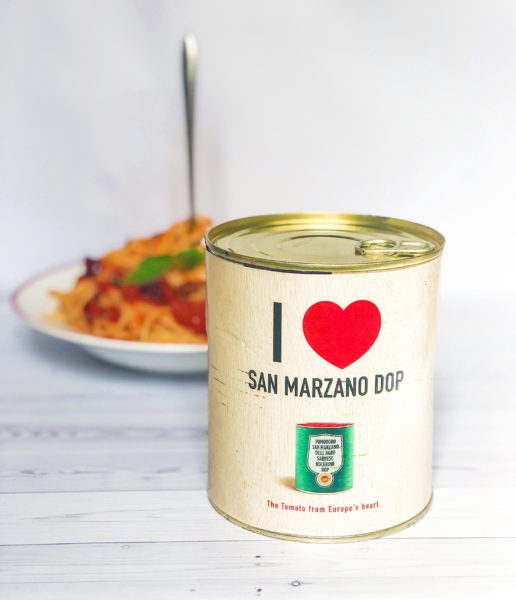
(You won’t see tomatoes at the store that look exactly like this promotional can, but you should look for “San Marzano DOP” on the label.)
San Marzano Italian Tomatoes, From Farm to Factory
Next, let’s take a look at how these beauties get from the field to your dinner table.

When it’s tomato season in Italy, the San Marzano region buzzes with activity. Even if you’re just walking or driving down the street, you will often see tractor trailers loaded with tomatoes passing by every few minutes.
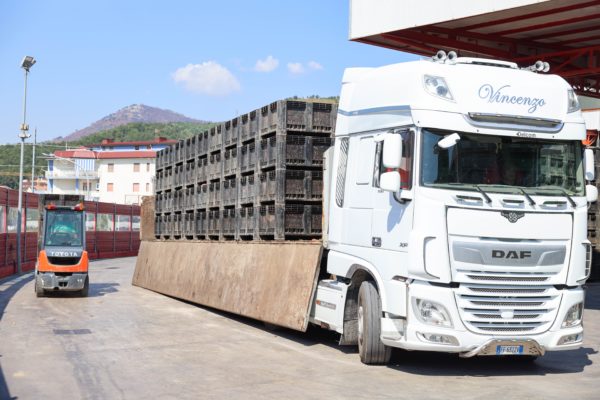
The tomato season runs from the middle of July through early October. During that time, the tomato factories operate nonstop, with seasonal workers working round-the-clock to take advantage of the tomatoes at their ripest.
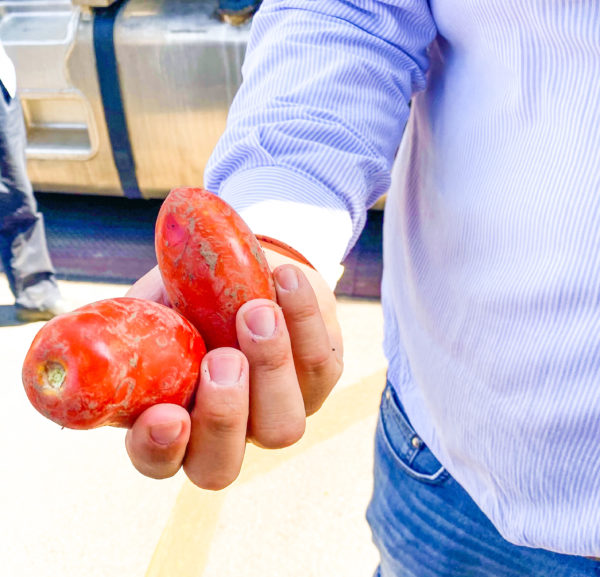
The first step in tomato processing begins with sorting and washing. As you can see above, the tomatoes arrive straight from the farm, often covered in dirt. The ideal fruit – the one that gets chosen for processing – is one that is perfectly ripe and whole. (Note that some of these photos are from the nearby Ciao Pomodori factory, where our pool photographer took pictures.)
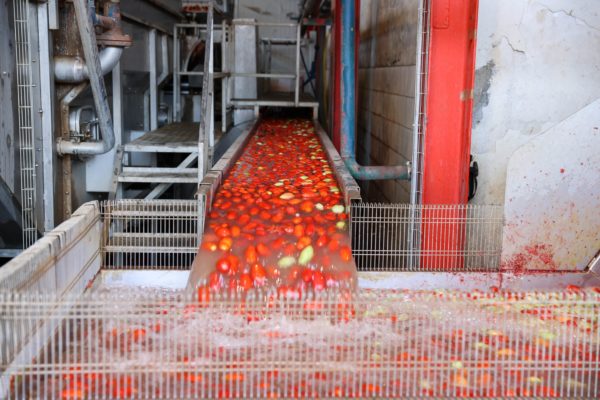
Next, a machine heats the chosen fruits to a high temperature to separate the skin from the flesh. And after that, an array of workers (almost exclusively women, by tradition) eliminate any damaged fruit. They also pull off any remaining stems and traces of skin from tomatoes on the production line.
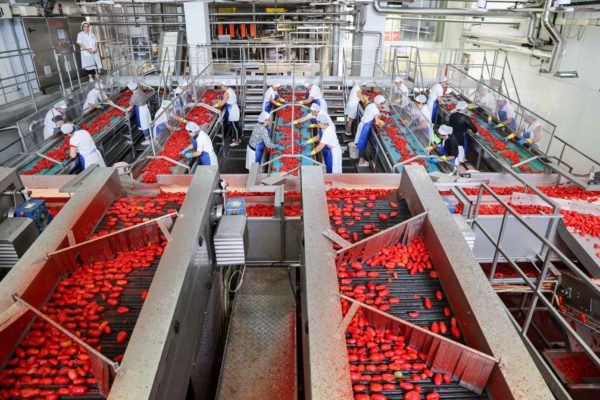
(Hey – there’s the Jolly Tomato standing on the sorting line!)
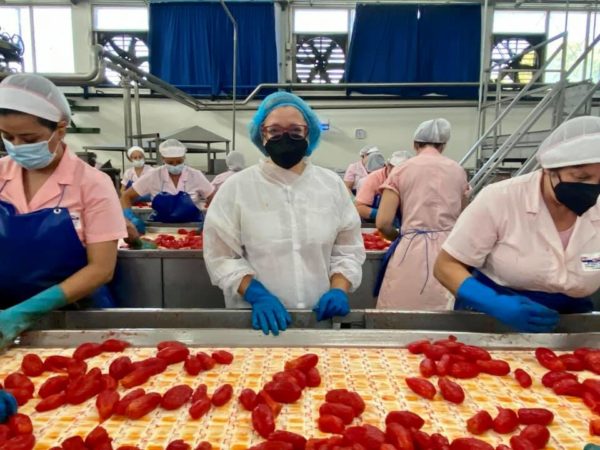
The Canning Process Begins
Next, a machine fills a line of cans with the whole peeled tomatoes and their juice. It then vacuum-seals them to preserve their freshness and flavor.
After that, the tomatoes are pasteurized at 212 degrees Fahrenheit to eliminate any microorganisms that could alter the product. And finally, the canned whole peeled tomatoes head down a conveyor belt for labeling and packing in cartons.
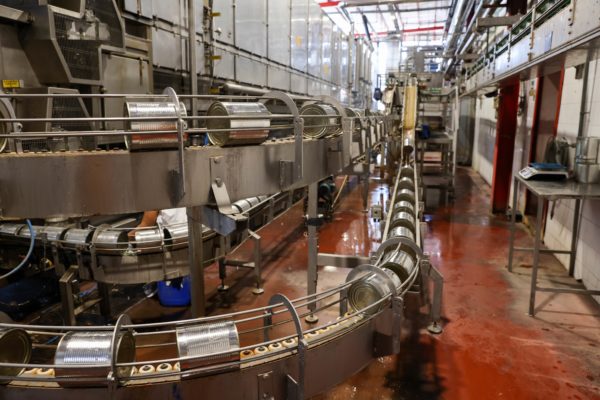
All told, it takes no longer than 36 hours to get the tomato from the field to the can. Each batch is carefully quality-tested to make sure that it holds up to the San Marzano DOP standards.
“The product is simple, but the process is very complex,” Christina Maiello, a food technologist with Calispa, told us. Yes, she added, the product is simply tomatoes, but behind each can stands a long line of rigorous testing and quality control to make sure that each tomato lives up to the San Marzano standard.
Italian Tomatoes and Tomato Products
Our group was on hand for the packing of whole tomatoes. However, there are many different tomato products that the companies produce during the harvest season.
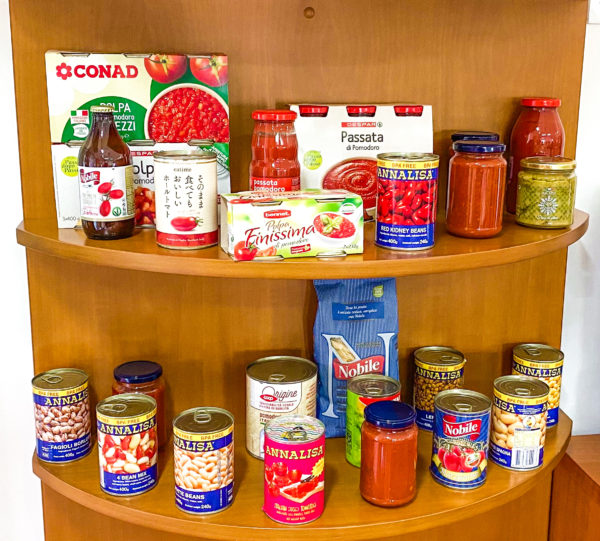
Calispa produces a range of products including tomato puree (known as passata in Italy), cherry tomatoes, and tomatoes flavored with garlic or spicy peppers. Calispa products are sold under the brand name Nobile, and are also packaged as Annalisa, Bennet, Despar, and Conad.
Of course, there are many different brand names that sell San Marzano DOP, so whatever you purchase, look for the San Marzano DOP certification.
If you can’t wait to cook, here are some of our favorite tomato recipes:
Authentic Italian Gnocchi with Tomato Sauce
Like it? Pin it!
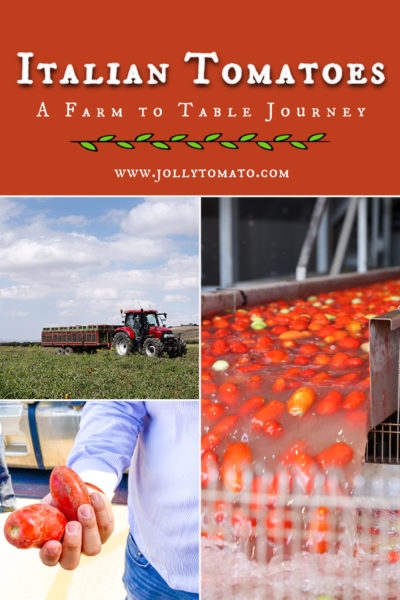
Italian Tomatoes: The journey of San Marzano tomatoes from farm to table.
Blogger disclosure: The Jolly Tomato traveled to Italy and learned about tomatoes as a guest of Greatest Tomatoes from Europe and ANICAV. We did not receive additional compensation for this post. All opinions expressed are our own.

 Hi! I'm Jeanne Fratello - a writer, reporter, and food enthusiast who is on a mission to write great stories about food and where your food comes from.
Hi! I'm Jeanne Fratello - a writer, reporter, and food enthusiast who is on a mission to write great stories about food and where your food comes from.
No comments yet.